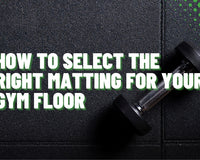When setting up your home gym, selecting the right flooring thickness is crucial for safety and performance.
The ideal thickness depends on the type of workouts you do. For heavy weightlifting, opt for 3/4 inch rubber mats to protect your floor and equipment. For lighter exercises, 1/4 to 1/2 inch may suffice. Ensure your flooring supports your fitness goals!
Different Gym Flooring Materials
When deciding how thick your flooring needs to be, you shoudl consider the different flooring types you could use.
Rubber

Rubber flooring is one of the most common types for home gyms. You can get rubber tiles and rolls, which come in all sorts of shapes and sizes.
They're ideal for protecting your floor from dropped weights and they have tons of cushioning as well. These can be anywhere from a few millimetres up to 40mm+.
See our full range of rubber gym flooring tiles here.
Foam

Foam or foam tiles are very soft and cushioned. They are some of the softest things that you could install on your gym floor.
If you're doing yoga, bodyweight exercises, and anything of this sort, they are ideal.
That said, you want to look for foam tiles that are at least 3/8 inches in thickness.
However, they will eventually start to degrade and break down, and even become compact, if heavy weights are repeatedly dropped on them.
Exercise Mats

So if you don't want to do any installation or any hard work, using portable mats is probably your best bet.
With portable mats, you can put them down anywhere you see fit, work out as you like, and then roll them back up. They can be up to 3/8 inches in thickness, so they're quite ideal for most circumstances.
Interlocking Tiles

If you're looking for a solid gym floor that is easy to install, going with interlocking rubber tiles is probably your best bet.
Interlocking tiles tend to be made out of foam or rubber. If you are looking for maximum cushioning, foam is your best bet.
However, if protecting the floor underneath is your biggest concern, then plastic tiles should be considered.
How Thick Should Gym Flooring Be?
If you're really worried about the floor underneath taking damage, aim for gym flooring that is about 30mm thick. Especially with a well-cushioned material such as rubber, will provide the floor underneath with ample protection.
It will also stop weights from bouncing too much in the event that you drop them. This can also help protect you from injury because it stops weights from bouncing into your shins.
However, you probably don't want to use anything thicker than 30mm, because this can reduce your overall stability and balance. If you sink into the floor too much every time you step on it, it can be a real problem.
On the other hand, you also don't want to go too thin. Personally, we recommend not going any thinner than 15mm. Anything thinner than that, and you won't have proper protection or cushioning.
Considerations When Choosing Gym Floor Thickness

When you are deciding how thick your gym floor should be, there are a few main considerations that you need to keep in mind.
Related Post: Guide to cleaning rubber gym flooring
The Exercises
Before anything else, you need to consider the type of exercises that you will be doing. This will determine the type of flooring that you need.
For instance, if you're just doing stretching, Pilates, yoga, or any other type of gentle workout, 15mm or less will probably be enough.
That said, if you're doing heavy-weight lifting and letting dumbbells drop on the ground, you might want to consider something thicker, up to an inch.
Noise
The next thing you need to consider when choosing how thick the floor for your gym should be is noise reduction.
Simply put, the more cushioning there is the more of those vibrations and impacts will be absorbed. If you're looking for maximum noise reduction, thicker is better.
Additionally, if you think that you'll be making too much noise, getting some silencer pads can be great for exercises like deadlifts.
The Base
The next thing to consider here is the base. For instance, is your gym on the ground floor, an upper floor, or in the basement?
If you have a very hard surface like concrete, going for something thicker is recommended, because you need something to cushion from the surface below.
However, if it's something like a wood floor or something softer, a slightly thinner gym floor will do.
FAQ
Can I Install Gym Floors Myself?
There are many types of gym flooring that you can install yourself, especially rubber floors. Rolled rubber gym floors don't require any special knowledge, and as long as you have a few extra helping hands, it should be just fine. See our guide on how to install rubber gym flooring.
Final Thoughts on Gym Flooring Thickness

At the very least, you want your gem force to be around 15mm thick, and if you're doing a lot of heavy lifting and need a good deal of cushioning, up to 30mm in thickness is recommended.





